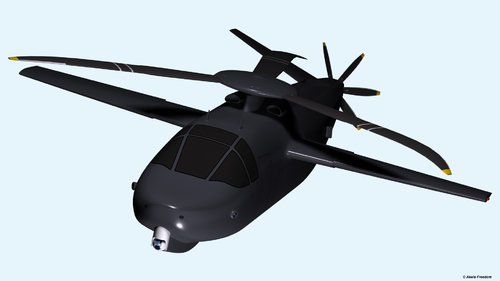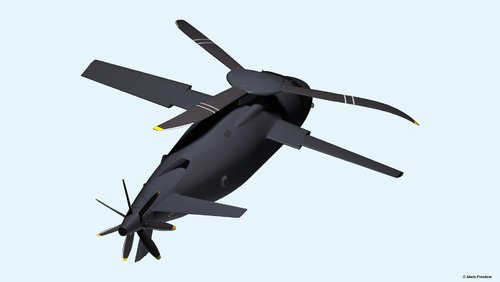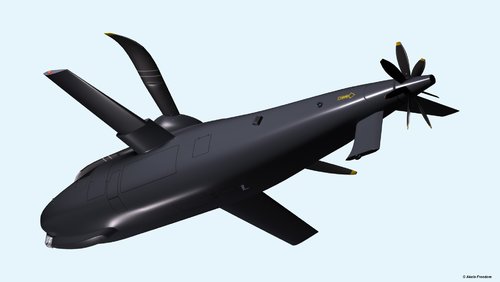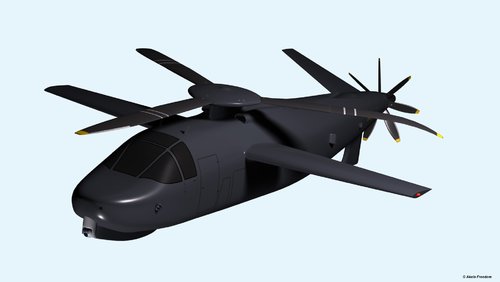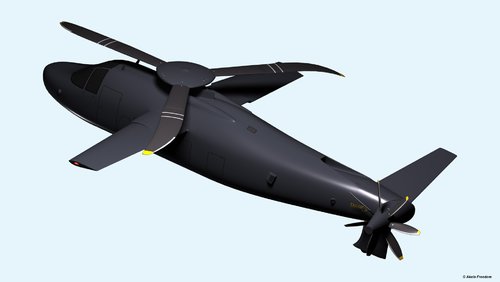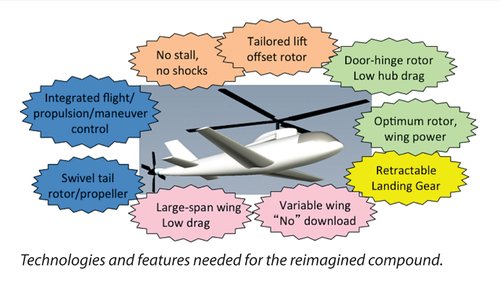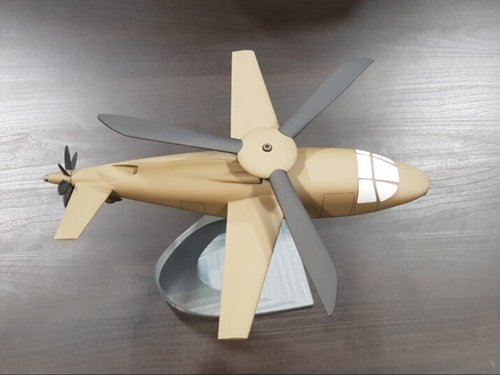If we could mash the two designs together (Sikorsky's powertrain and Bells' fuselage) we would have one good-looking helo. Lets see if potential and performance beats cost and simplicity (altought I still have my doubts about Bell's "APU").
You are using an out of date browser. It may not display this or other websites correctly.
You should upgrade or use an alternative browser.
You should upgrade or use an alternative browser.
JMR (Joint Multi-Role) & FVL (Future Vertical Lift) Programs
- Thread starter Grey Havoc
- Start date
- Joined
- 24 November 2008
- Messages
- 1,549
- Reaction score
- 2,612
Karem's swiveling tail rotor / propulsor merged into Bell's fuselage would be a promising combo as well 
- Joined
- 3 October 2007
- Messages
- 1,960
- Reaction score
- 1,197
It's obvious at this point, that one is getting the Blackhawk replacement and the other is getting FARA. I'm betting on the V-280 as the Blackhawk Replacement and the Sikorsky design for the FARA. Partly due to Bell's outstanding performance on the V-280 program, and, as many of you have already noted, the ability of the Sikorsky FARA design to lose the weapons "doors" and carry SOF in the cabin as an adjunct to FARA.
One idea a lot of people operate from is that X2 is as mature a technology as Tilt-Rotor. The spanner in the works is that so far what they've done with it and what they've achieved is not as much as has been expected. I'm assuming, prematurely maybe, that Bell will be one of the final two for FARA since it's the lowest risk, and Army definitely wants a low risk alternative and Sikorsky because while higher risk, has flown their rotor/propulsor concept. And, as far as it goes, when you consider actual rotorcraft program design and build, experience they are the two "safest" contestants. Regarding SOF folks, it depends on how much that capability will be worth to the Army, especially since FLRAA, especially the Marines' version, AURA, fits right into what SOCOM wants.
Last edited:
- Joined
- 18 October 2006
- Messages
- 4,211
- Reaction score
- 4,921
I agree that any of the contenders could have produced a superb rotorcraft. Loved the pragmatism of the AVX design, and would have really liked to see the Karem all electric high speed rotorcraft jump start new ways to do aircraft controls. With Boeing, I am willing to bet we have not seen the last of their proposed dynamics systems. At the end of the day given the skittishness of the Congress (rightfully so) toward Army Aviation programs, going with the two most mature rotorcraft houses was the right move.
I'd still like to see an Apache with a pusher prop.
I suspect that wish is more likely now. I think the Army will placate the third helicopter house with Block II CH-47 and at least one more Apache upgrade. With Bell getting the FLRAA and Sikorsky getting FARA, all of the Congressional staffs from the great state of anywhere with helicopter plants will be happy.
- Joined
- 2 August 2006
- Messages
- 3,256
- Reaction score
- 1,528
One idea a lot of people operate from is that X2 is as mature a technology as Tilt-Rotor. The spanner in the works is that so far what they've done with it and what they've achieved is not as much as hs been expected. I'm assuming, prematurely maybe, that Bell will be one of the final two for FARA since it's the lowest risk, and Army definitely wants a low risk alternative and Sikorsky because while higher risk, has flown their rotor/propulsor concept. And, as far as it goes, when you consider actual rotorcraft program design and build, experience they are the two "safest" contestants. Regarding SOF folks, it depends on how much that capability will be worth to the Army, especially since FLRAA, especially the Marines' version fits right into what SOCOM wants.
I get exactly what you're thinking, but I was thinking of the Sikorsky FARA design as more of a Little Bird replacement. I definitely see both of them being used by SOCOM depending on the mission.
- Joined
- 3 October 2007
- Messages
- 1,960
- Reaction score
- 1,197
I agree that any of the contenders could have produced a superb rotorcraft. Loved the pragmatism of the AVX design, and would have really liked to see the Karem all electric high speed rotorcraft jump start new ways to do aircraft controls. With Boeing, I am willing to bet we have not seen the last of their proposed dynamics systems. At the end of the day given the skittishness of the Congress (rightfully so) toward Army Aviation programs, going with the two most mature rotorcraft houses was the right move.
I'd still like to see an Apache with a pusher prop.
I suspect that wish is more likely now. I think the Army will placate the third helicopter house with Block II CH-47 and at least one more Apache upgrade. With Bell getting the FLRAA and Sikorsky getting FARA, all of the Congressional staffs from the great state of anywhere with helicopter plants will be happy.
Well, Army canceled the Block II Chinook beyond 69 for Special Ops last year in order to fund FARA/FLRAA , but Congress (no doubt responding to lobbyists) injected $28 million in advance procurement funds to act as a placeholder for more. It'll be interesting to see if Block II comes back, because FLRAA (and its USMC derivative) and FARA are the only big programs starting up for a while and given that, wither Boeing? Keep in mind that Boeing has never put into production a (not a just a new version of an existing) helicopter of its own design and has only flown five airframes of its own design. The powers that be might be wondering how bad would it really be if Boeing stopped building Chinooks in the 2020s.
Given what it would cost, would a pusher prop Apache really be worth it relative to a FLRAA derivative?
I for one am waiting to see if it's all that certain that Sikorsky gets FARA, given the uncertainties. This is, after all, their fifth attempt to replace OH-58 and Army can't afford another program collapse on this.
Last edited:
- Joined
- 31 December 2006
- Messages
- 803
- Reaction score
- 363
all of the Congressional staffs from the great state of anywhere with helicopter plants will be happy.
SPF Quote Of The Month IMO
shin_getter
ACCESS: Top Secret
- Joined
- 1 June 2019
- Messages
- 1,109
- Reaction score
- 1,493
What is the synergy of air-launched effects with FARA? A helicopter hiding below the horizon isn't a good command and control node and the limited payload (and imparted energy) of the platform means drones it launch would have poor performance relative to drones launched from other platforms.
Precision over the horizon weapons in the form of missiles or drones seem to threaten the concept of below the horizon helicopters more so than land forces that have additional means of stealth and costs relatively little in any case.
Precision over the horizon weapons in the form of missiles or drones seem to threaten the concept of below the horizon helicopters more so than land forces that have additional means of stealth and costs relatively little in any case.
jsport
what do you know about surfing Major? you're from-
- Joined
- 27 July 2011
- Messages
- 7,733
- Reaction score
- 5,751
The powers that be might be wondering how bad would it really be if Boeing stopped building Chinooks in the 2020s.I agree that any of the contenders could have produced a superb rotorcraft. Loved the pragmatism of the AVX design, and would have really liked to see the Karem all electric high speed rotorcraft jump start new ways to do aircraft controls. With Boeing, I am willing to bet we have not seen the last of their proposed dynamics systems. At the end of the day given the skittishness of the Congress (rightfully so) toward Army Aviation programs, going with the two most mature rotorcraft houses was the right move.
I'd still like to see an Apache with a pusher prop.
I suspect that wish is more likely now. I think the Army will placate the third helicopter house with Block II CH-47 and at least one more Apache upgrade. With Bell getting the FLRAA and Sikorsky getting FARA, all of the Congressional staffs from the great state of anywhere with helicopter plants will be happy.
Well, Army canceled the Block II Chinook beyond 69 for Special Ops last year in order to fund FARA/FLRAA , but Congress (no doubt responding to lobbyists) injected $28 million in advance procurement funds to act as a placeholder for more. It'll be interesting to see if Block II comes back, because FLRAA (and its USMC derivative) and FARA are the only big programs starting up for a while and given that, wither Boeing? Keep in mind that Boeing has never put into production a (not a just a new version of an existing) helicopter of its own design and has only flown five airframes of its own design. The powers that be might be wondering how bad would it really be if Boeing stopped building Chinooks in the 2020s.
Given what it would cost, would a pusher prop Apache really be worth it relative to a FLRAA derivative?
I for one am waiting to see if it's all that certain that Sikorsky gets FARA, given the uncertainties. This is, after all, their fifth attempt to replace OH-58 and Army can't afford another program collapse on this.
It wouldnt be bad.
- Joined
- 18 October 2006
- Messages
- 4,211
- Reaction score
- 4,921
[/QUOTE]
The powers that be might be wondering how bad would it really be if Boeing stopped building Chinooks in the 2020s.
It wouldnt be bad.
[/QUOTE]
Based on? I only ask since it appears that the US Congress thinks keeping the line alive is important. What do you do with the work force? The equipment? The sub-contractors who build connectors, wire bundles, MFD's etc? I would accept that going back to being a rebuild facility is a viable alternative to new aircraft, but shuttering the place would be a political battle royal.
The powers that be might be wondering how bad would it really be if Boeing stopped building Chinooks in the 2020s.
It wouldnt be bad.
[/QUOTE]
Based on? I only ask since it appears that the US Congress thinks keeping the line alive is important. What do you do with the work force? The equipment? The sub-contractors who build connectors, wire bundles, MFD's etc? I would accept that going back to being a rebuild facility is a viable alternative to new aircraft, but shuttering the place would be a political battle royal.
jsport
what do you know about surfing Major? you're from-
- Joined
- 27 July 2011
- Messages
- 7,733
- Reaction score
- 5,751
The powers that be might be wondering how bad would it really be if Boeing stopped building Chinooks in the 2020s.
It wouldnt be bad.
[/QUOTE]
Based on? I only ask since it appears that the US Congress thinks keeping the line alive is important. What do you do with the work force? The equipment? The sub-contractors who build connectors, wire bundles, MFD's etc? I would accept that going back to being a rebuild facility is a viable alternative to new aircraft, but shuttering the place would be a political battle royal.
[/QUOTE]
rebuilding but only to limited extent because ..mentioned on the Chinook thread the USG needs pay workers to study and design the next generation hvy lifter as the Chinook's time has long past. Can it even carry one cmbt loaded JTLV?
It wouldnt be bad.
[/QUOTE]
Based on? I only ask since it appears that the US Congress thinks keeping the line alive is important. What do you do with the work force? The equipment? The sub-contractors who build connectors, wire bundles, MFD's etc? I would accept that going back to being a rebuild facility is a viable alternative to new aircraft, but shuttering the place would be a political battle royal.
[/QUOTE]
rebuilding but only to limited extent because ..mentioned on the Chinook thread the USG needs pay workers to study and design the next generation hvy lifter as the Chinook's time has long past. Can it even carry one cmbt loaded JTLV?
jsport
what do you know about surfing Major? you're from-
- Joined
- 27 July 2011
- Messages
- 7,733
- Reaction score
- 5,751
Picture 40b is interesting as it also displays how Karem is triming the bird in High speed flight: with dissimilar wing pitch angle.
The retreating blade unbalance is countered that way (look closely at the picture) and wings also acts as an anti-torque when rear combo-rotor is swiveled back.
The retreating blade unbalance is countered that way (look closely at the picture) and wings also acts as an anti-torque when rear combo-rotor is swiveled back.
- Joined
- 24 November 2008
- Messages
- 1,549
- Reaction score
- 2,612
Can you provide a link to the source of those pics? Thx in advance!Maybe AFSOC could do the right thing and buy the Karem.
jsport
what do you know about surfing Major? you're from-
- Joined
- 27 July 2011
- Messages
- 7,733
- Reaction score
- 5,751
- Joined
- 24 November 2008
- Messages
- 1,549
- Reaction score
- 2,612
Seems my last comments were over optimistic as the pictures are not from the manufacturer.
Thank you @VTOLicious
Thank you @VTOLicious
jsport
what do you know about surfing Major? you're from-
- Joined
- 27 July 2011
- Messages
- 7,733
- Reaction score
- 5,751
The manufacturer has stated the design eliminates retreating blade slowing. The craft does not have to break horizontal for foward flight and it does not suffer from the range killing drag of counter rotating blades.
Last edited:
- Joined
- 3 June 2011
- Messages
- 18,338
- Reaction score
- 12,240
The manufacturer has stated the design eliminates retreating blade slowing.
How does it do that?
jsport
what do you know about surfing Major? you're from-
- Joined
- 27 July 2011
- Messages
- 7,733
- Reaction score
- 5,751
Speed And Size Drive Advanced Options For U.S. Army’s Armed Scout
Oct 18, 2019
Graham Warwick | Aviation Week & Space Technology
The U.S. Army faces an array of options for its Future Attack Reconnaissance Aircraft (FARA). To meet the demanding size and speed requirements, four of the contenders have each unveiled different rotorcraft configurations. The fifth, Boeing, is keeping its design under wraps.
The Army’s requirements for a maximum speed of at least 180 kt. in an armed scout rotorcraft that can fit within a 40 X 40-ft. “box,” enabling it to fly between buildings in urban combat, is pushing manufacturers beyond conventional helicopter configurations.
Externally, Bell’s 360 Invictus is the most conventional of the offerings revealed so far, with a single main rotor and ducted tail rotor. But the design is optimized for high speed, with a low-drag tandem-seat fuselage, a wing to offload the rotor and a supplemental power unit to augment the single 3,000-shp-class General Electric T901 turboshaft to help push the helicopter to its 185-kt. top speed.
- Karem offers high-speed, active-rotor compound
- Sikorsky proposes derivative of coaxial-rotor S-97
AVX Aircraft, teamed with L3Harris Technologies, is proposing its Coaxial Compound Helicopter. This has side-by-side seating, a wing to offload the coaxial rotor and dual ducted fans for speed and agility. Details of Boeing’s design are sensitive, and the company does not want to give its competitors an edge, but the Army is fully informed on its initial design work says Mark Cherry, Phantom Works president.
Sikorsky is emphasizing growth capability to stay ahead of evolving threats with its FARA offering, the Raider X. Based on the X2 coaxial rigid-rotor compound configuration, the aircraft is a development of the S-97 Raider prototype now in flight-testing. The Raider X is about 20% larger, with a 14,000-lb. gross weight, compared to 11,000 lb. for the S-97, and a 39-ft.-dia. rotor, compared to 34 ft. for the Raider.
The Raider X will surpass the FARA program’s threshold of 180 kt. Sikorsky is not saying how fast it will fly but notes the S-97 has reached 215 and 207 kt. in level flight. This exceeds the 205-kt. target in the Army’s initial capability requirements document, says Tim Malia, Sikorsky’s director of future vertical lift-light.
The Army subsequently reduced the threshold maximum speed to enable a wider competition for the FARA program. But Malia says the greater speed and payload capability of the X2 configuration compared to a conventional helicopter provides growth capacity. “We looked at a single main rotor helicopter for FARA, but it would be minimally compliant in the early 2020s.
We need to be able to stay ahead of the threat into the 2030s and 2040s,” he says.
“Single main rotor will not be able to keep up. It’s already tapped out meeting the minimal FARA requirements. It does not have the ability to grow capability over time,” says
Malia. “We didn’t want to pull out all the stops to be minimally compliant when we had X2 able to carry more payload and go faster.”
The Raider X has four-blade rotors and a pusher propulsor. The coaxial rotors generate lift only on the advancing sides, eliminating retreating-blade stall and enabling higher speed. At high speed, 90% of the engine power goes to the propulsor, says Bill Fell, senior experimental test pilot. The propulsor is declutched at low speed to reduce noise.
The Raider X closely resembles the S-97 prototype, with side-by-side seating. Compared with tandem seating, this improves crew coordination and situational awareness, says Malia. “And we can do it aerodynamically because of the robust performance inherent in X2. We are not trying to get out every last ounce of drag.”
Behind the cockpit is a large internal weapons bay. Internal carriage of missiles and unmanned aircraft—which the Army calls air-launched effects (ALE)—is a FARA requirement, but Malia says the cabin-like volume of Raider X’s bay provides growth space for future, larger systems. “The minimum threshold works now, but what if in 2030 there are new ALE that can be decisive but can’t be carried?” he asks.
The Raider X is powered by a single T901—which will be government-furnished equipment to all FARA bidders. “We do not have an additional engine to increase speed,” Malia says. “We use the power available and have a solid design built around it. The T901 provides speeds out of the chute in excess of requirements, and as it improves we can take direct benefit.”
Sikorsky is using the industry-funded S-97 prototype to reduce risk for its FARA bid, conducting flight tests to validate models and optimize the Raider X design. This includes flying new rotor blades designed to reduce drag and vibration. “We are getting exactly the results the models said,” says Malia.
With two rotor systems and a propulsor, Sikorsky is paying close attention to the Raider X’s cost. “We have done a complete affordability analysis and design to cost. We are extremely confident we will come in under the cost goal,” he says.
Several divisions of parent Lockheed Martin are part of Sikorsky’s FARA team, Malia says, including Aeronautics, Missiles and Fire Control, and Rotary and Mission Systems. Swift Engineering will build the airframe if Sikorsky wins one of two FARA competitive prototype contracts scheduled to be awarded in March 2020. The Army flyoff is planned for 2023, with the first unit to be equipped by 2028.
Teamed with Northrop Grumman and Raytheon, Karem Aircraft is proposing a winged compound helicopter with an actively controlled main rotor, the AR40. “The hallmark feature is it can fly fast,” says Thomas Berger, Karem’s FARA program manager. “We go past the threshold requirement by about 20% and do it without any additional auxiliary propulsion on a single T901.” This implies a speed of about 215 kt.
Founded by Predator designer Abe Karem, the company is better known for its development of the Optimum Speed Tilt Rotor (OSTR). But the Army’s requirement that FARA fit within a 40 X 40-ft. box ruled out a tiltrotor design. The designation AR40 stands for “40-ft. active rotor.”
The AR40 has a single main rotor, wing and a unique swiveling tail rotor, which provides anti-torque control at low speed but swivels aft to provide propulsion for higher forward speed. “This is the best design we know to attack the requirement. It has low drag and low vibration at high speed,” Berger says.
In a conventional rotor, a swashplate and pitch links mechanically transmit cyclic and collective blade-pitch command to the rotor head. In Karem’s active rotor, the blades are individually controlled by electric actuators in the hub. This allows blade pitch to be precisely controlled to maximize performance and minimize drag and vibration at high speed, says Berger.
Additionally, power for the full-authority individual blade control actuators is generated in the hub, says Berger, eliminating the need for slip rings to transfer electrical power to the rotating rotor. The rotor has three stiff, lightweight blades and a rigid, hingeless hub. The lack of a swashplate and pitch links results in a slim pylon between fuselage and rotor, reducing drag.
To achieve high speed, “we reduce drag significantly and unload the rotor to the wing,” says Berger. “The swiveling tail rotor means we do not have the edgewise drag of a tail rotor. We store all the ordnance inside, stow the gun and fair the targeting turret.” The AR40 has side-by-side seating. This improves crew coordination and provides additional room behind the cockpit for mission equipment or a cabin for personnel. “It’s space for free,” he says.
While no active rotor has progressed beyond the R&D stage yet, Karem is developing the component technology under the Army’s Joint Multi-Role Technology Demonstration (JMR TD) program. Under this program, the company will ground-test a 36-ft. variable-speed active rotor for its OSTR design for the Army’s planned Future Long-Range Assault Aircraft.
The OSTR uses the same active control, lightweight blade and rigid hub technology as the AR40. The JMR TD rotor “is under component test, with the integrated test next year,” says Berger. “It will directly help reduce risk for [the AR40’s] individual blade control, rigid hub, blades, etc.”
Karem has worked with the Army’s science and technology community for many years, first on Joint Heavy Lift and later on JMR TD, but the company is still a relative unknown, so it has teamed with heavyweight partners Northrop for airframe production and Raytheon for the open-architecture mission system.
“Karem is the driving pioneer of the rotor and drive system.
Northrop Grumman brings full OEM production and support capability,” Berger says. Northrop company Scaled Composites is also involved and will likely build the prototype if the AR40 wins one of the two competitive prototype contracts.
Northrop Grumman Mission Systems will provide the avionics and cockpit integration. Raytheon will perform mission-system integration using its experience with modular open-architecture systems. “We have teamed with big OEMs who have the ability to provide managed risk,” says Berger.
—With Lee Hudson in Washington
jsport
what do you know about surfing Major? you're from-
- Joined
- 27 July 2011
- Messages
- 7,733
- Reaction score
- 5,751
obviate the retreating blade stall phenomen.
Tomcatvip has mentioned twice and I have mentioned before as well so this will be the 6th n 7th time mentioned..thinkin Karem has never been given a chance.. Some cave dwellin.
Last edited:
- Joined
- 18 October 2006
- Messages
- 4,211
- Reaction score
- 4,921
The powers that be might be wondering how bad would it really be if Boeing stopped building Chinooks in the 2020s.
It wouldnt be bad.
Based on? I only ask since it appears that the US Congress thinks keeping the line alive is important. What do you do with the work force? The equipment? The sub-contractors who build connectors, wire bundles, MFD's etc? I would accept that going back to being a rebuild facility is a viable alternative to new aircraft, but shuttering the place would be a political battle royal.
[/QUOTE]
rebuilding but only to limited extent because ..mentioned on the Chinook thread the USG needs pay workers to study and design the next generation hvy lifter as the Chinook's time has long past. Can it even carry one cmbt loaded JTLV?
[/QUOTE]
Your point is valid certainly valid about Chinook carrying capacity for modern equipment. I would also agree that Boeing could develop a heavy lifter, but doubt they would do so without US government funding. Since all of the funds are going into FARA, FLRAA, and ALE I think it doubtful there is an appetite for a heavy lifter. Besides I cannot see the U.S. Army wanting to buy an aircraft likely to cost ~$80M to ~$100M. Myopic perhaps, but I think it the reality of the situation. Thoughts?
It would be nice to see AFSOC or SOCOM go out on its own, but to date they have not seemed willing to fund exclusive programs. Given the numbers the Special Operations community would likely buy they would be rather expensive.
Thanks for posting the great pictures of the AR-40
Last edited:
jsport
what do you know about surfing Major? you're from-
- Joined
- 27 July 2011
- Messages
- 7,733
- Reaction score
- 5,751
rebuilding but only to limited extent because ..mentioned on the Chinook thread the USG needs pay workers to study and design the next generation hvy lifter as the Chinook's time has long past. Can it even carry one cmbt loaded JTLV?The powers that be might be wondering how bad would it really be if Boeing stopped building Chinooks in the 2020s.
It wouldnt be bad.
Based on? I only ask since it appears that the US Congress thinks keeping the line alive is important. What do you do with the work force? The equipment? The sub-contractors who build connectors, wire bundles, MFD's etc? I would accept that going back to being a rebuild facility is a viable alternative to new aircraft, but shuttering the place would be a political battle royal.
[/QUOTE]
Your point is valid certainly valid about Chinook carrying capacity for modern equipment. I would also agree that Boeing could develop a heavy lifter, but doubt they would do so without US government funding. Since all of the funds are going into FARA, FLRAA, and ALE I think it doubtful there is an appetite for a heavy lifter. Besides I cannot see the U.S. Army wanting to buy an aircraft likely to cost ~$80M to ~$100M. Myopic perhaps, but I think it the reality of the situation. Thoughts?
It would be nice to see AFSOC or SOCOM go out on its own, but to date they have not seemed willing to fund exclusive programs. Given the numbers the Special Operations community would likely buy they would be rather expensive.
Thanks for posting the great pictures of the AR-40
[/QUOTE]
you are correct, some Presidential leadership would need to lead but in the middle of these trillion dollar expenditures why not add some $110m craft as long as they have a deep magazine DEW def system.
- Joined
- 24 November 2008
- Messages
- 1,549
- Reaction score
- 2,612
I hope promising technology unsuccessful in FARA-proposals will pop up in another program, maybe.
Even unsuccessful FARA designs advanced the future of vertical lift:
https://www.verticalmag.com/news/fa...edium=email&utm_term=top-story&utm_content=V1
Even unsuccessful FARA designs advanced the future of vertical lift:
https://www.verticalmag.com/news/fa...edium=email&utm_term=top-story&utm_content=V1
Attachments
- Joined
- 18 October 2006
- Messages
- 4,211
- Reaction score
- 4,921
I also would like to see that. However I doubt it. Without government funding to work through the details there is only a very small likelihood. I suspect Karem will turn to the EVTOL effort they have working and funding for. Boeing will go back to improving the AH64 and CH47. AVX sadly will likely fade away unless they can find someone to fund continued work on the dynamic components.I hope promising technology unsuccessful in FARA-proposals will pop up in another program, maybe.
Even unsuccessful FARA designs advanced the future of vertical lift:
https://www.verticalmag.com/news/fa...edium=email&utm_term=top-story&utm_content=V1
jsport
what do you know about surfing Major? you're from-
- Joined
- 27 July 2011
- Messages
- 7,733
- Reaction score
- 5,751
meanwhile time, resource and effort are wasted on obsolete underperforming technology. Most likely a foreign power will steal/mimic the more advanced technology and we will once again zoom backward.I also would like to see that. However I doubt it. Without government funding to work through the details there is only a very small likelihood. I suspect Karem will turn to the EVTOL effort they have working and funding for. Boeing will go back to improving the AH64 and CH47. AVX sadly will likely fade away unless they can find someone to fund continued work on the dynamic components.I hope promising technology unsuccessful in FARA-proposals will pop up in another program, maybe.
Even unsuccessful FARA designs advanced the future of vertical lift:
https://www.verticalmag.com/news/fa...edium=email&utm_term=top-story&utm_content=V1
improving the 64 is worth it (stealth w/ a huge spinning rotor seems... so 64 is fine) the 47 though
- Joined
- 18 October 2006
- Messages
- 4,211
- Reaction score
- 4,921
stealth w/ a huge spinning rotor seems...
I agree. *shrug*
Don't forget that there is zero azimuth b/w the radar and the helicopter and that radar have frequencies at magnitudes greater than that of a rotating blade (rpm Vs Hz). Spinning the rotor at an appropriate value will turn it immobile or only slowly rotating for the radar. If the rotor is properly designed, the radar might see next to nothing.

Last edited:
_Del_
I really should change my personal text... Or not.
- Joined
- 4 January 2012
- Messages
- 1,315
- Reaction score
- 1,812
Don't underestimate the ability of a properly run design house with no overhead to grab enough SBIR contracts to keep the lights on. There are some bright minds over there. They could conceivably never build a single piece of hardware and stay afloat by letting SBiR pay for R&D and selling or licensing the resulting patents.AVX sadly will likely fade away unless they can find someone to fund continued work on the dynamic components.
- Joined
- 3 June 2011
- Messages
- 18,338
- Reaction score
- 12,240
obviate the retreating blade stall phenomen.
Tomcatvip has mentioned twice and I have mentioned before as well so this will be the 6th n 7th time mentioned..thinkin Karem has never been given a chance.. Some cave dwellin.
You said, "The manufacturer has stated the design eliminates retreating blade slowing."
That's not what they do. The retreating blade is going to have reduced relative motion to the airflow as you speed up no matter what. What they're doing is eliminating its impact. The is what Sikorsky X-2 technology (and the previous XCH-59) does (by having a lifting blade on both sides combined with a rigid rotor). It's what the AH-56 did.
- Joined
- 18 October 2006
- Messages
- 4,211
- Reaction score
- 4,921
A fair point to be sure. My concern is that AVX is rather geriatric and has not brought in new blood. I am sure that a “retired” aero-engineer club has sufficient savvy to keep the lights on for a while, but once the fiscal fortunes go away, well…Don't underestimate the ability of a properly run design house with no overhead to grab enough SBIR contracts to keep the lights on. There are some bright minds over there. They could conceivably never build a single piece of hardware and stay afloat by letting SBiR pay for R&D and selling or licensing the resulting patents.AVX sadly will likely fade away unless they can find someone to fund continued work on the dynamic components.
jsport
what do you know about surfing Major? you're from-
- Joined
- 27 July 2011
- Messages
- 7,733
- Reaction score
- 5,751
Are the Sikorsky blades completely "unloaded " in winged based flight? Where are large wings. Do they use no main rotor for completely horizontal flight?obviate the retreating blade stall phenomen.
Tomcatvip has mentioned twice and I have mentioned before as well so this will be the 6th n 7th time mentioned..thinkin Karem has never been given a chance.. Some cave dwellin.
You said, "The manufacturer has stated the design eliminates retreating blade slowing."
That's not what they do. The retreating blade is going to have reduced relative motion to the airflow as you speed up no matter what. What they're doing is eliminating its impact. The is what Sikorsky X-2 technology (and the previous XCH-59) does (by having a lifting blade on both sides combined with a rigid rotor). It's what the AH-56 did.
- Joined
- 3 June 2011
- Messages
- 18,338
- Reaction score
- 12,240
Are the Sikorsky blades completely "unloaded " in winged based flight? Where are large wings. Do they use no main rotor for completely horizontal flight?obviate the retreating blade stall phenomen.
Tomcatvip has mentioned twice and I have mentioned before as well so this will be the 6th n 7th time mentioned..thinkin Karem has never been given a chance.. Some cave dwellin.
You said, "The manufacturer has stated the design eliminates retreating blade slowing."
That's not what they do. The retreating blade is going to have reduced relative motion to the airflow as you speed up no matter what. What they're doing is eliminating its impact. The is what Sikorsky X-2 technology (and the previous XCH-59) does (by having a lifting blade on both sides combined with a rigid rotor). It's what the AH-56 did.
Because you have an advancing blade on both sides at all times you still have lift on both sides. The rigid rotors reduce flapping of the retreating blade (which loses more lift the faster you go). Doesn't need a wing. Both Karem's design and the AH-56 have the wing to unload the rotor and eliminate roll-off in the direction of the retreating blade.
jsport
what do you know about surfing Major? you're from-
- Joined
- 27 July 2011
- Messages
- 7,733
- Reaction score
- 5,751
Point is the Raider doesn't completely unload..Are the Sikorsky blades completely "unloaded " in winged based flight? Where are large wings. Do they use no main rotor for completely horizontal flight?obviate the retreating blade stall phenomen.
Tomcatvip has mentioned twice and I have mentioned before as well so this will be the 6th n 7th time mentioned..thinkin Karem has never been given a chance.. Some cave dwellin.
You said, "The manufacturer has stated the design eliminates retreating blade slowing."
That's not what they do. The retreating blade is going to have reduced relative motion to the airflow as you speed up no matter what. What they're doing is eliminating its impact. The is what Sikorsky X-2 technology (and the previous XCH-59) does (by having a lifting blade on both sides combined with a rigid rotor). It's what the AH-56 did.
Because you have an advancing blade on both sides at all times you still have lift on both sides. The rigid rotors reduce flapping of the retreating blade (which loses more lift the faster you go). Doesn't need a wing. Both Karem's design and the AH-56 have the wing to unload the rotor and eliminate roll-off in the direction of the retreating blade.
- Joined
- 3 June 2011
- Messages
- 18,338
- Reaction score
- 12,240
Doesn't need to be. The advancing rotor blades accomplish the same thing as a wing.Point is the Raider doesn't completely unload..Are the Sikorsky blades completely "unloaded " in winged based flight? Where are large wings. Do they use no main rotor for completely horizontal flight?obviate the retreating blade stall phenomen.
Tomcatvip has mentioned twice and I have mentioned before as well so this will be the 6th n 7th time mentioned..thinkin Karem has never been given a chance.. Some cave dwellin.
You said, "The manufacturer has stated the design eliminates retreating blade slowing."
That's not what they do. The retreating blade is going to have reduced relative motion to the airflow as you speed up no matter what. What they're doing is eliminating its impact. The is what Sikorsky X-2 technology (and the previous XCH-59) does (by having a lifting blade on both sides combined with a rigid rotor). It's what the AH-56 did.
Because you have an advancing blade on both sides at all times you still have lift on both sides. The rigid rotors reduce flapping of the retreating blade (which loses more lift the faster you go). Doesn't need a wing. Both Karem's design and the AH-56 have the wing to unload the rotor and eliminate roll-off in the direction of the retreating blade.
jsport
what do you know about surfing Major? you're from-
- Joined
- 27 July 2011
- Messages
- 7,733
- Reaction score
- 5,751
The Russians wanted the Kamov 50 to ironically be a air superiority helicopter only to discover that counter rotaters touch blades in high dynamic maneuver. So not only is there range killing drag but there is no air to air combat manuver in counter rotaters..
- Joined
- 3 June 2011
- Messages
- 18,338
- Reaction score
- 12,240
The Russians wanted the Kamov 50 to ironically be a air superiority helicopter only to discover that counter rotaters touch blades in high dynamic maneuver.
The difference between rigid rotors and conventional.

